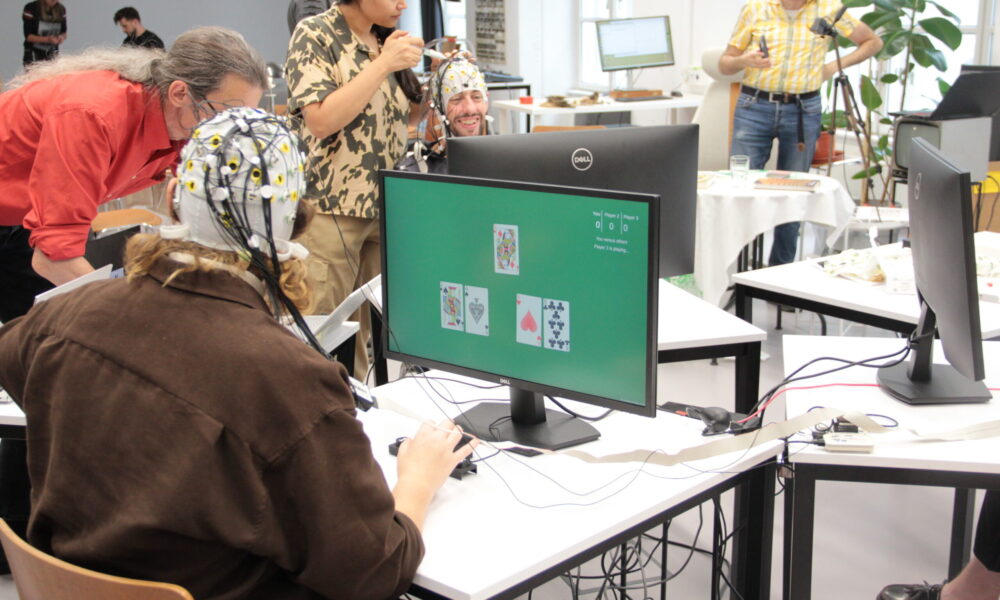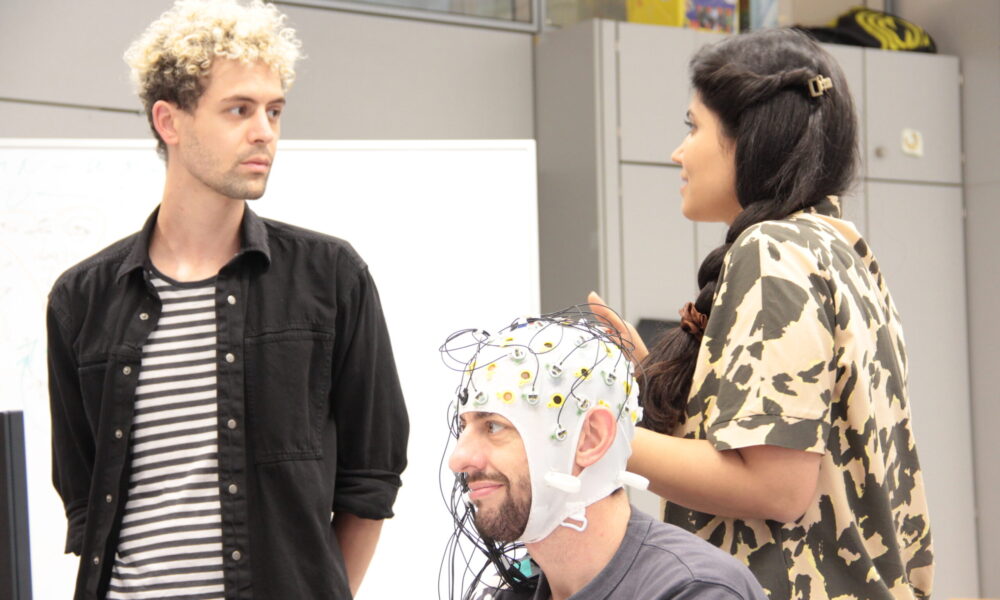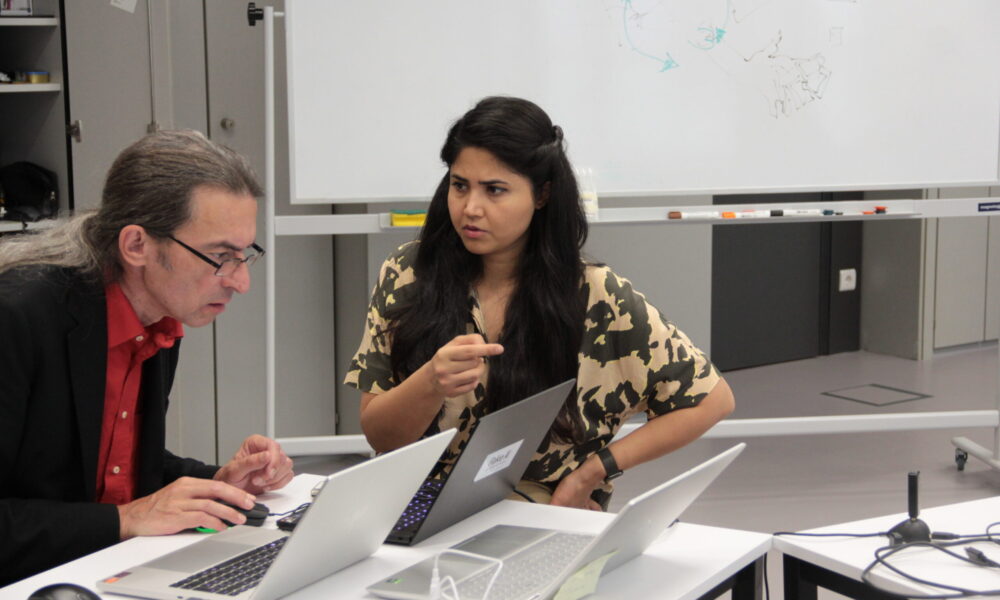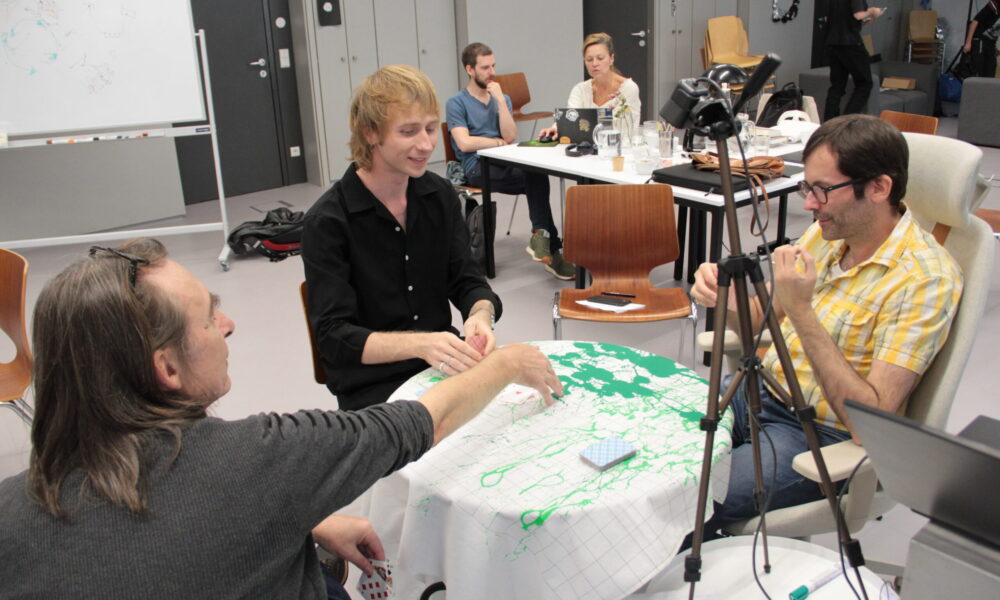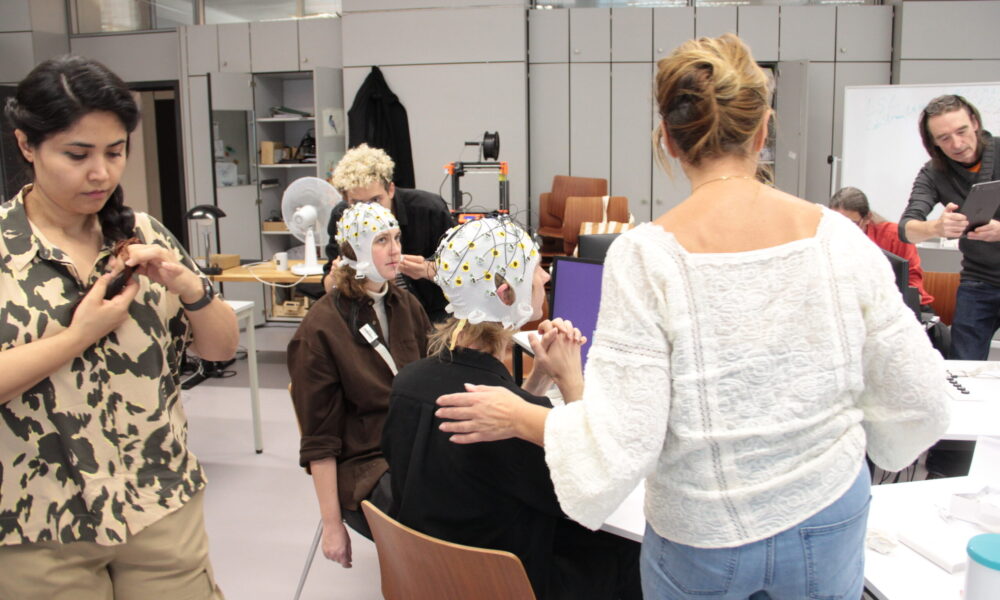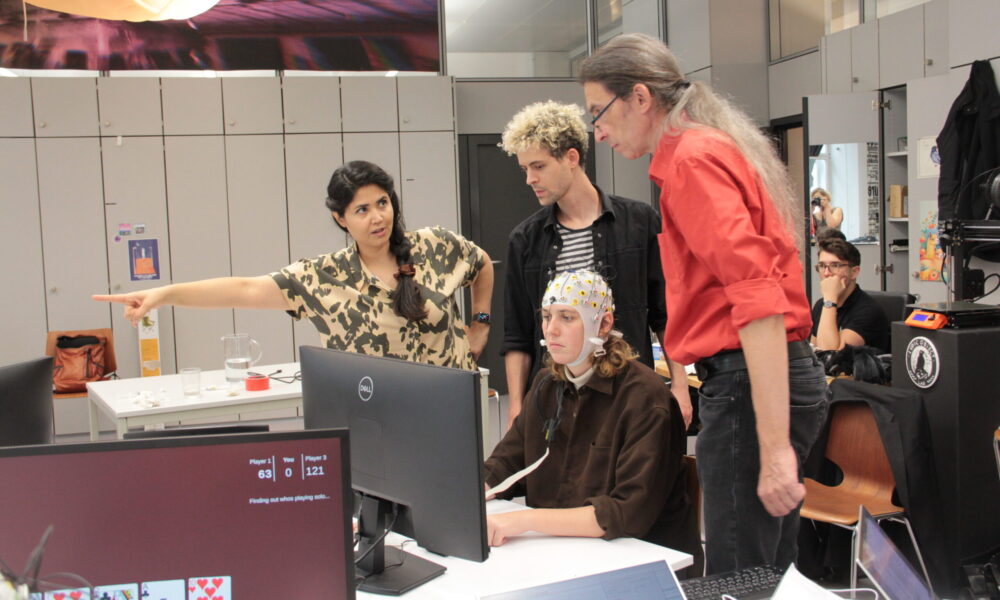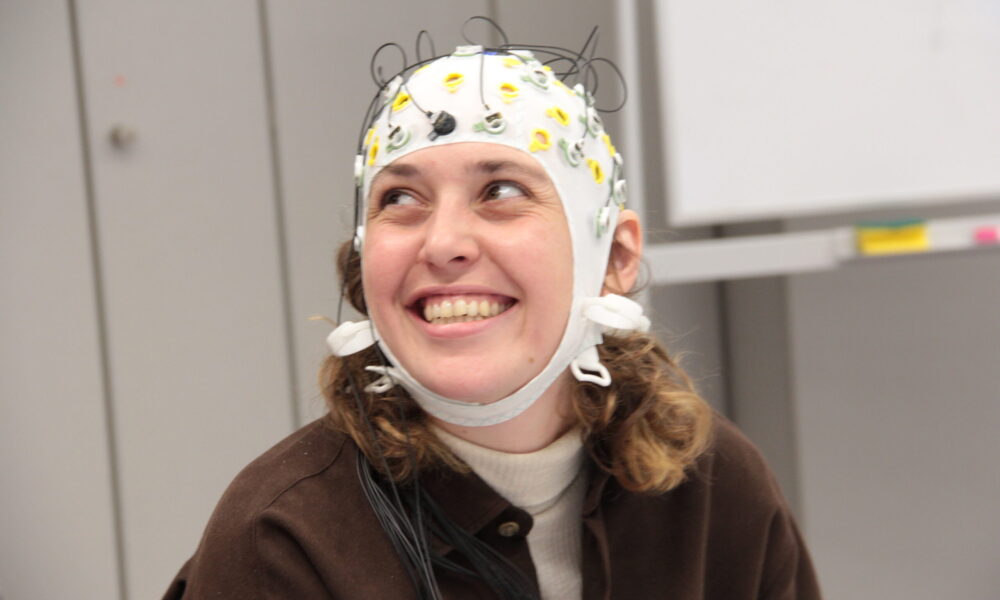Work in progress
The Psycho-Ludic Approach
Exploring play for a viable future – AR787
Kartenspielen im Dienst der Wissenschaft – OE 1 Beitrag
December 2025
In this broadcast, the Jet Lag All Stars serve as test subjects. Adorned with tight EEG caps and wired up with multiple cables, they face off in a competitive card game. What happens in our brains when we choose cooperation, and what happens when we try to eliminate an opponent on our own? Media artist Margarete Jahrmann aims to explore this through this experiment.
In her projects, Jahrmann combines experimental psychology and artistic research to investigate gaming motivations. She uses the neologism “psycholudic” to describe this convergence of psychological, emotional, and playful elements.
This experiment, titled “501 EEG Card Game,” is part of the PEEK project “The Psycholudic Approach: Exploring Play for a Viable Future,” funded by the FWF and WWTF. In each round, the three card-playing subjects must choose between cooperation and competition. The participants’ brain activity is recorded via EEG to determine, for example, if there are parallels between two partners who opt for a cooperative approach. It is hoped that this experiment will provide insights into attention, risk behavior, and strategic decision-making in gaming.
Participating in the implementation of the experiment are Stefan Glasauer, a research partner from the Brandenburg University of Technology and a specialist in EEG and electronic interfaces, as well as Teresa Demmer, a PhD candidate in neuroscience (“Computational Neuroscience”).
On December 15, 2025, Jahrmann was awarded the Austrian Art Prize 2025 for her body of work by the Federal Ministry for Housing, Arts, Culture, Media and Sport (BMWKMS).
Full article here: https://oe1.orf.at/programm/20251208/816333/Kartenspielen-im-Dienst-der-Wissenschaft
Die Jet Lag All Stars stellen sich in dieser Sendung als Probanden zur Verfügung. Mit engen EEG-Häubchen geschmückt und mehrfach verkabelt treten sie in einem kompetitiven Kartenspiel gegeneinander an. Was passiert in unserem Gehirn, wenn wir uns für Kooperation entscheiden und was, wenn wir versuchen, einen Gegner alleine auszuschalten? Das möchte die Medienkünstlerin Margarete Jahrmann mit diesem Experiment ergründen.
In ihren Projekten verbindet Jahrmann experimentelle Psychologie und künstlerische Forschung, um Spiel-Motivationen zu erforschen. Mit der Wortschöpfung “psycholudisch” bezeichnet sie diese Zusammenführung aus psychologischen, emotionalen und spielerischen Elementen.
“501 EEG-Kartenspiel” heißt dieses Experiment innerhalb des von FWF und WWTF geförderten PEEK-Projekts “Der psycholudische Ansatz. Die Erforschung des Spiels für eine verträgliche Zukunft”. Die drei kartenspielenden Probanden müssen sich in jeder Spielrunde zwischen Kooperation oder Konkurrenz entscheiden. Dabei wird die Gehirnaktivität der Teilnehmenden über das EEG-Verfahren aufgezeichnet, um etwa zu ergründen, ob es Parallelen zwischen zwei Spielpartnern gibt, die sich für ein kooperierendes Vorgehen entscheiden. Man erhofft sich durch dieses Experiment Einblicke in in Aufmerksamkeit, Risikoverhalten und strategische Entscheidungen im Spiel.
An der Umsetzung des Experiments beteiligt sind Stefan Glasauer, Forschungspartner von der Brandenburgischen Technischen Universität, ein Spezialist für EEG und elektronische Interfaces sowie Teresa Demmer, PHD-Kandidatin in den Neurowissenschaften (“Computational Neurosiences”).
Für ihr Gesamtwerk wurde Jahrmann am 15. Dezember 2025 vom Bundesministerium für Wohnen, Kunst, Kultur, Medien und Sport (BMWKMS) der Österreichische Kunstpreis 2025 verliehen.
Beitrag online unter: https://oe1.orf.at/programm/20251208/816333/Kartenspielen-im-Dienst-der-Wissenschaft
Interview Der Standard – “KI deletes collective Memory”
October 2025
Margarete Jahrmann and The Psycholudic Approach were featured in “Der Standard” (22/10/2025).
The article highlights how our “psycholudic” experiments explore AI’s impact on collective memory.
The psycholudic method explained: Jahrmann describes our approach as combining “psychological, emotional and ludic, playful elements” to rethink game mechanics. The article also covers the 501 EEG Card Game, which uses brain monitoring to study cooperation and competition dynamics.
The feature comes ahead of Jahrmann receiving the Austrian Art Prize 2025 on December 15.
Robopsy project spotlight: The piece details our interactive game investigating the 1936 murder of philosopher Moritz Schlick, where players compare how different AI models (ChatGPT, Mistral, DeepSeek, Llama) interpret historical events. Analysis of 206 chat protocols revealed significant biases—ChatGPT emphasized right-wing ideology as motive while other models downplayed political context.
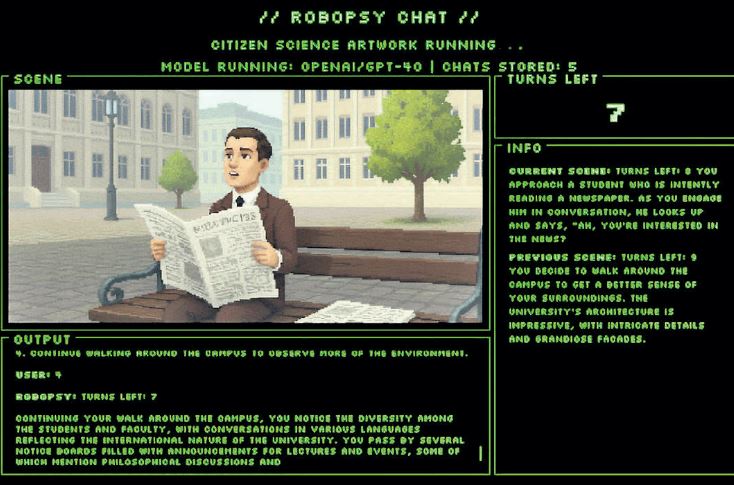
Full article: Der Standard, page 18, “KI löscht kollektive Erinnerung” by Mario Wasserfaller
TED AI Vienna
October 2025
TEDAI Vienna is Europe’s official three-day TED event on Artificial Intelligence – a conference where business leaders, inventors and thinkers across industry sectors gather for signature TED Talks, mind-expanding discovery sessions and unforgettable side events.
We had the privilege of exhibiting at this year’s conference with a booth in the Hofburg’s Marmorsaal, where we presented two interactive AI art projects to attendees: the LUDIC PSY AI ENGINE, which shows insight into possible future game worlds, and an emanation of the ROBOPSY project – a collective memory role play installation.
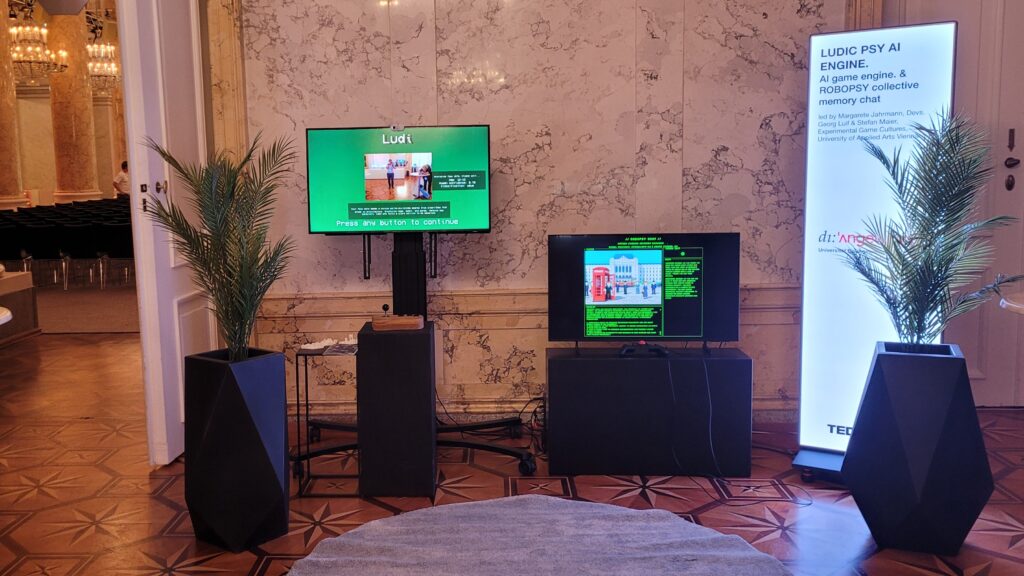

Throughout the conference, we had rich conversations with attendees about emotional AI, player agency, and the future of creative expression in machine-generated worlds.
Special thanks to Anna Koprivc, Interactive Exhibits Lead at TEDAI Vienna, for making our participation possible and seamless.
LUDIC PSY AI ENGINE
September 2025
An emanation of the artistic research project “The Psycholudic Approach“ (Austrian Science Fund FWF/ PEEK) led by Margarete Jahrmann, AI engine developer Georg Luif – Experimental Game Cultures, University of Applied Arts Vienna.
Playing means looking closely at the artefact – when looking closely to the LUDIC PSY, You sacrifice Your facial data!
A facial recognition system classifies players as a certain type of player – You can try to change this classification with emotional facial expressions! Based on the outcome, the AI engine generates a game level with game mechanics. AI creatures are generated, objects placed and by navigating through the new world, the boundary between creator and participant dissolves.
We use the open-source Godot Engine and its native scripting to generate worlds in real time, guided by Wave Function Collapse for architecture and terrain. The face recognition software weaves prompts from each participant’s facial expressions, which feed an LLM Large Language Model (Chat GPT 4.0) that transforms words into living code, inviting players to shape a fluid, ever-evolving art experience. This Psycholudic transformation of psychic states as expressed in the face of players into a game allows to generate prompts to conjure both, levels and new viable behaviours.
This semi- auto-creative dance hints at a future where prompts power the creation of new spaces and character behaviors, while Wave Function Collapse maintains coherent rules for terrain and architecture. Real-time scripting keeps the process immediate, ensuring that each player´s input directly reshapes the virtual domain.
We question: Is conventional gaming only surveillance and capitalist data harvesting for AI worlds?
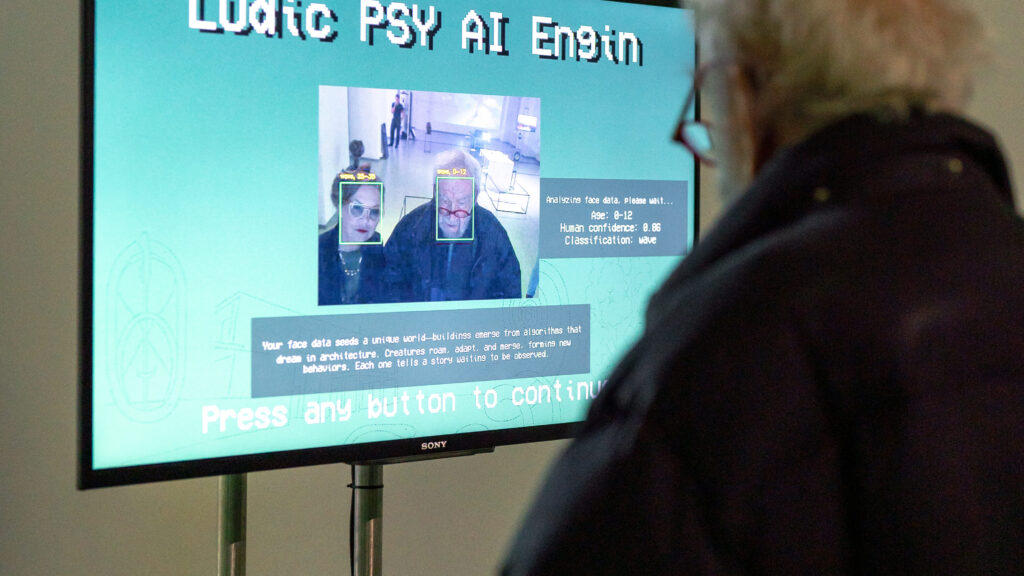
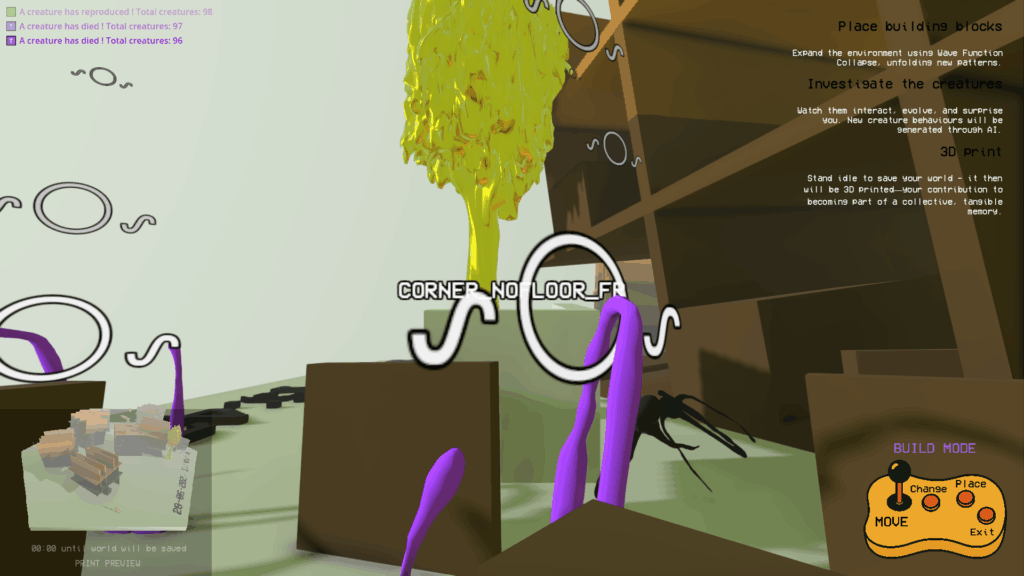
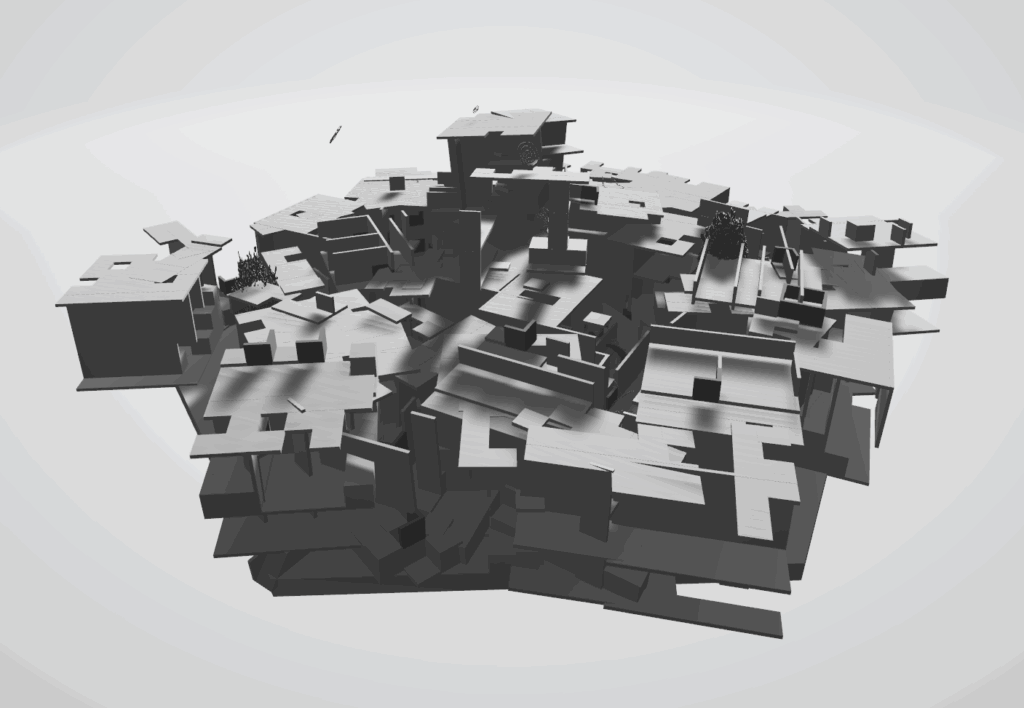
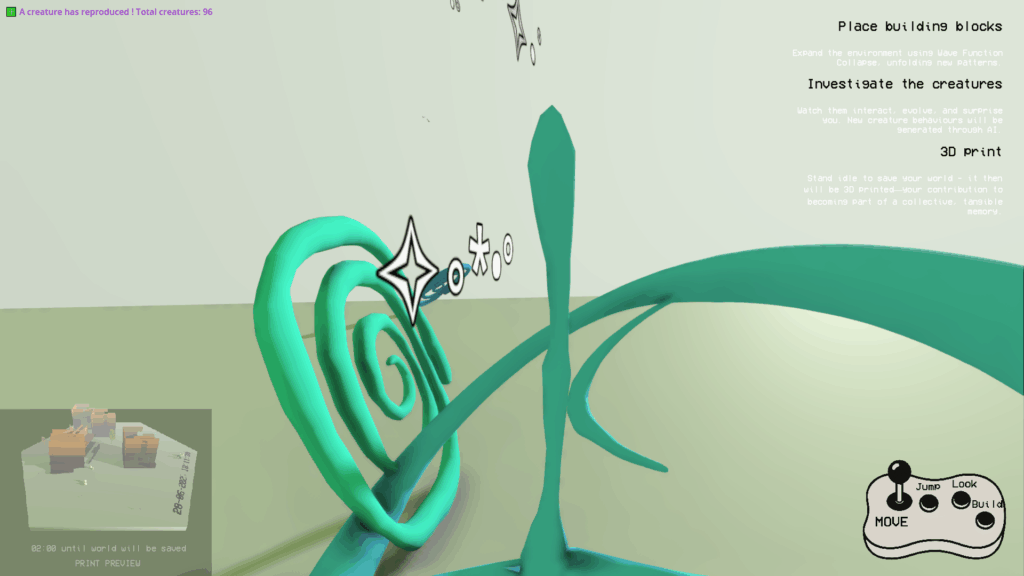
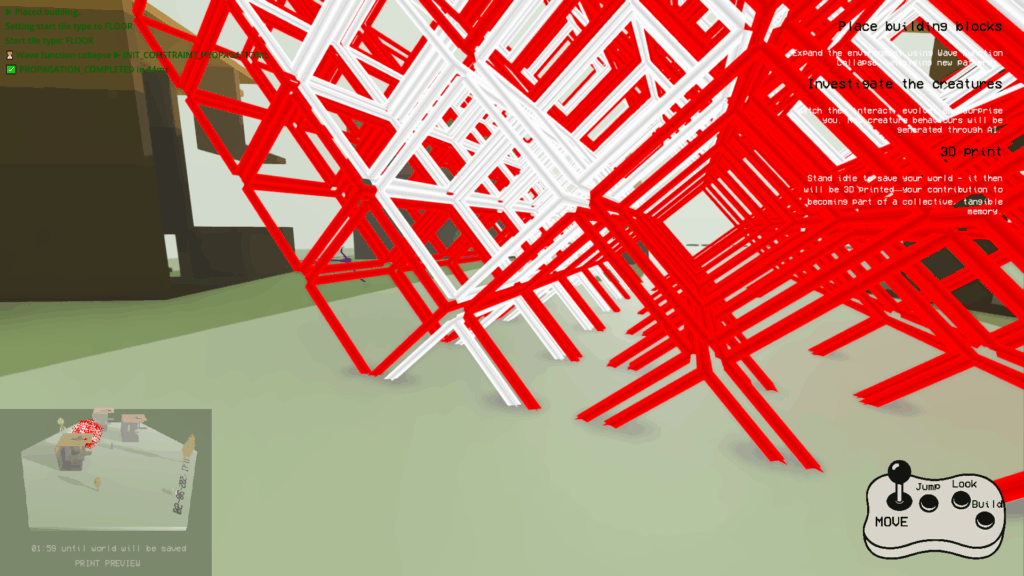
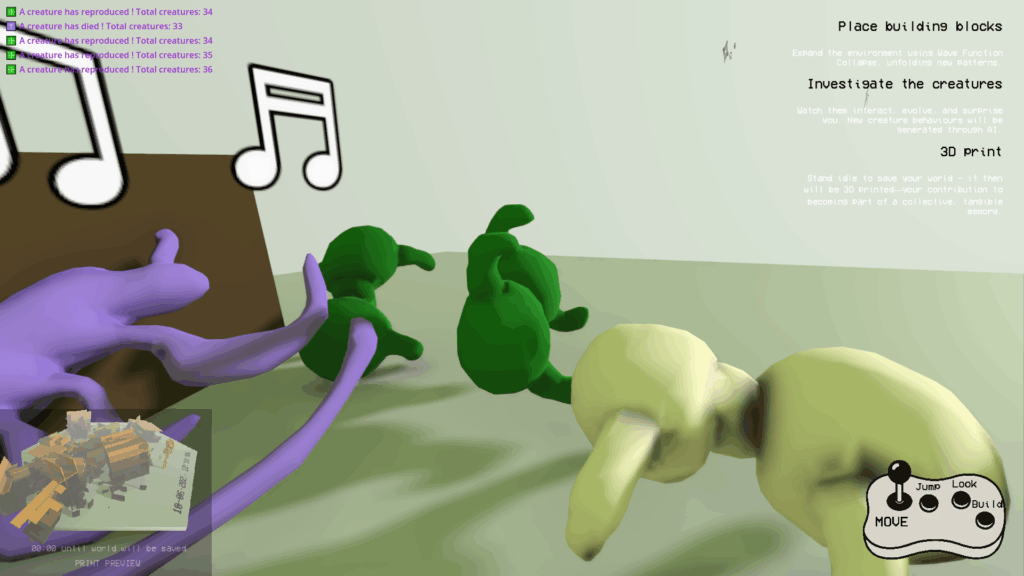
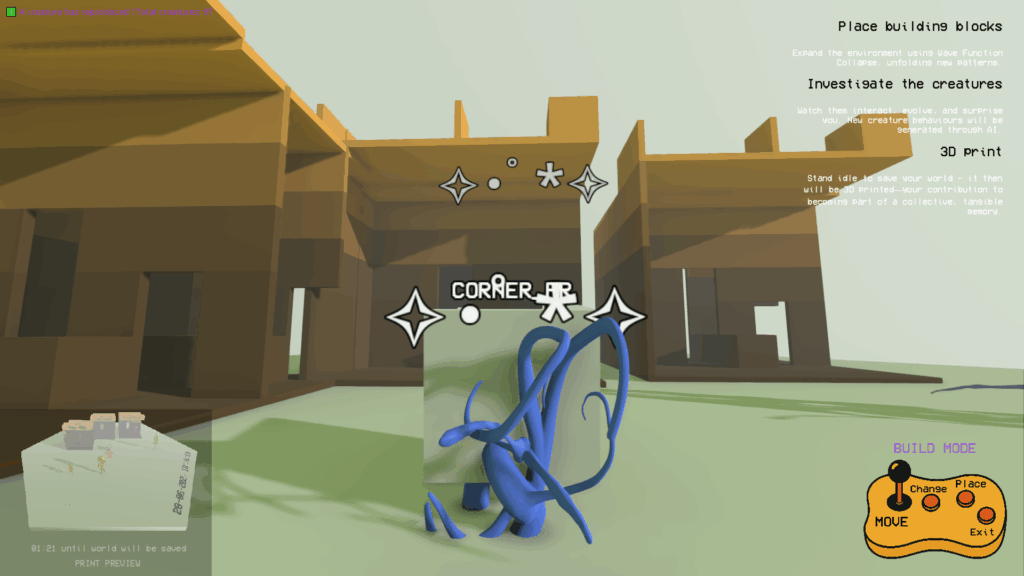
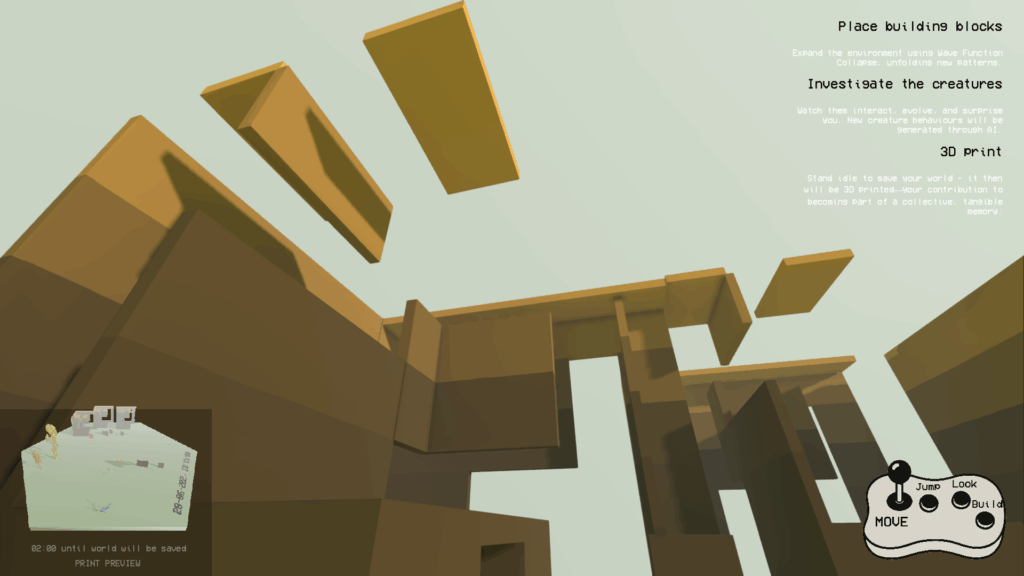
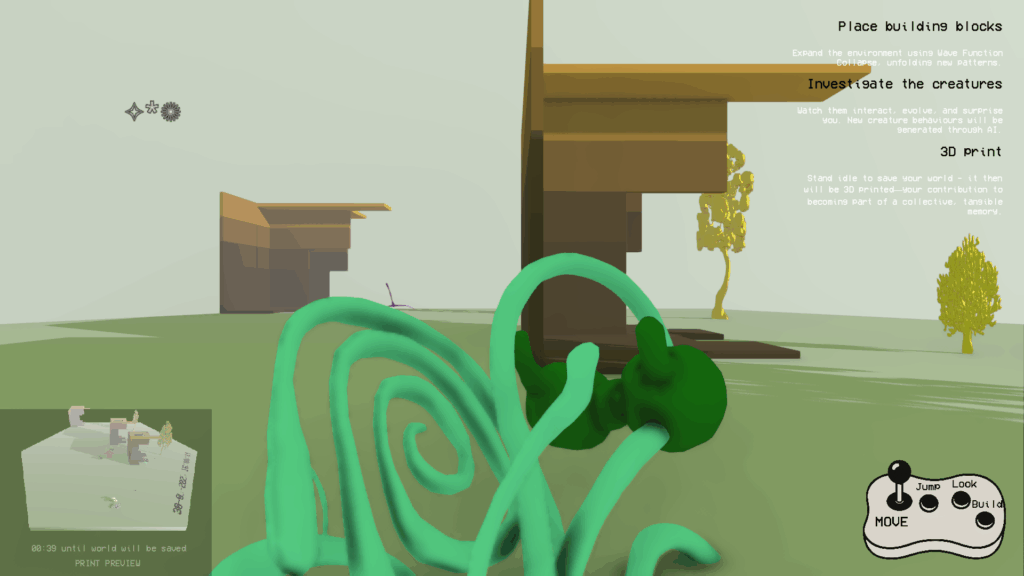
Eine Ausgliederung des künstlerischen Forschungsprojekts „The Psycholudic Approach“ (Österreichischer Wissenschaftsfonds FWF/ PEEK) unter der Leitung von Margarete Jahrmann, KI-Engine-Entwickler Georg Luif/ Experimental Game Cultures, Universität für angewandte Kunst Wien.
Spielen bedeutet, das Artefakt genau zu betrachten – wenn Sie die LUDIC PSY AI ENGINE genau betrachten, spenden Sie Ihre Gesichtsdaten! Ein AI System klassifiziert Ihre Emotion. Anhand des Ergebnisses generiert eine AI gestützte FLOW-Engine ein Spiellevel mit neuen entsprechenden Spielmechaniken. Künstliche KI-Kreaturen entstehen und verbinden sich, wie ein erweitertes Game of Life. Spieler*innen können neue Objekte platzieren und navigieren durch eine neue Welt.
Wir verwenden die quelloffene Godot-Engine und ihr Skripting, um personalisierte AI Spiellevels in Echtzeit zu generieren, die von Wave Function Collapse für Architektur und Terrain gesteuert werden. Aus den Gesichtsausdrücken der Spielenden entstehen prompts für das Large Language Model (Chat GPT 4.0), das Code generiert. Diese Psycholudik AI engine ist eine Kombination psychischer Zustände mit einer live gecodeten Spiel-Engine mit eigenen neu generierten Wesen und ihrem Verhalten – in dem wir eventuell neue verträglichere Spielmechaniken erkennen können.
Dieser semi-auto-kreative Tanz deutet auf eine Zukunft hin, in der neue Verhaltensweisen im Spiel entstehen. Echtzeit-Skripting hält den Prozess unmittelbar und stellt sicher, dass der Input jeders Spielenden- erfasst durch Gesichtserkennung – die virtuelle Domäne direkt umgestaltet.
Wir fragen: Ist konventionelles Gaming Überwachung und kapitalistisches Data Harvesting für KI-Welten?
Monkeys, Machines, and Multi-Perspectivities OPENING
May 2025
Transmissions from Within the Ludic Mind -Otto-Wagner PSK Kassenhalle/ AIL. An exhibition by the PSYCHOLUDIC / ROBOPSY researchgroup.
07.05- 28.06.2025
Monkeys, Machines, and Multiperspectivities is a call to embrace the transformative power of play. As visitors move through this experimental landscape, they will encounter new perspectives, rethink their roles in the world, and explore how small shifts in perspective can unlock vast potential for creative and collective action. Through this dynamic intersection of art, science, and play, the project offers a vision of a future defined by empathy, interconnectedness, and the endless possibilities of the ludic mind.
Presented through the lens of the Psycho-Ludic Approach (with methods by artistic research, experimental psychology and neuroscience), this exhibition challenges conventional ideas of agency, perspective, and societal structures and explore alternative motivations for play. The current global crises show that humanity’s exploitation-based strategies have come to an end: conquering new worlds, accumulating possessions and winning. These strategies, which are now failing, are reflected in games and their mechanisms.
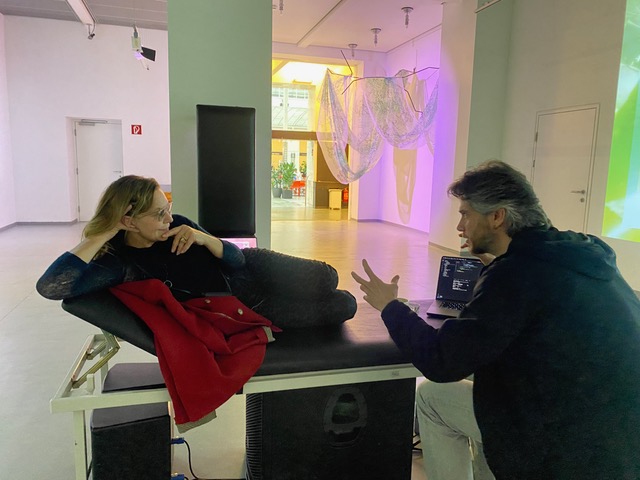
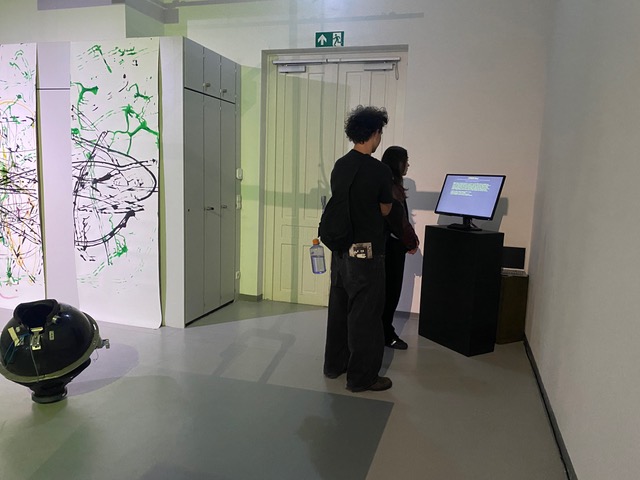
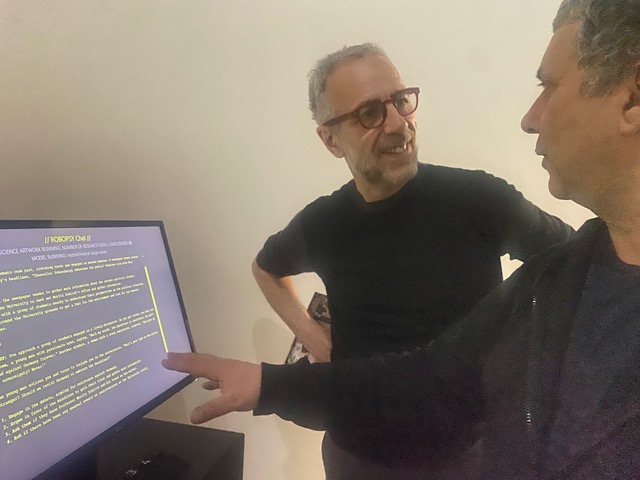
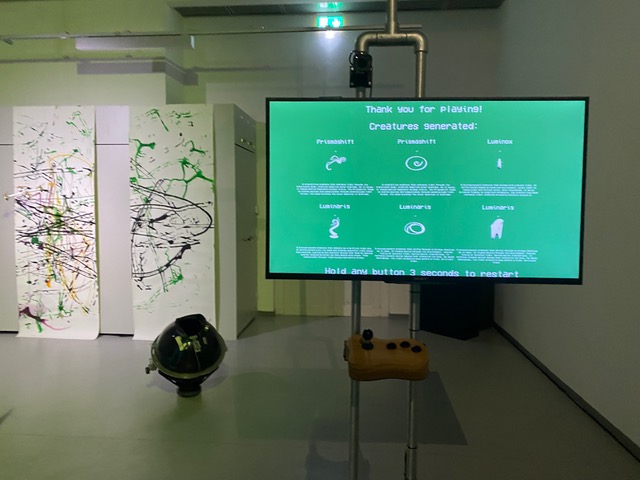
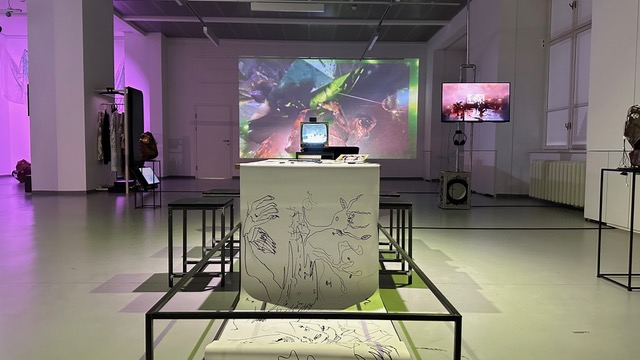
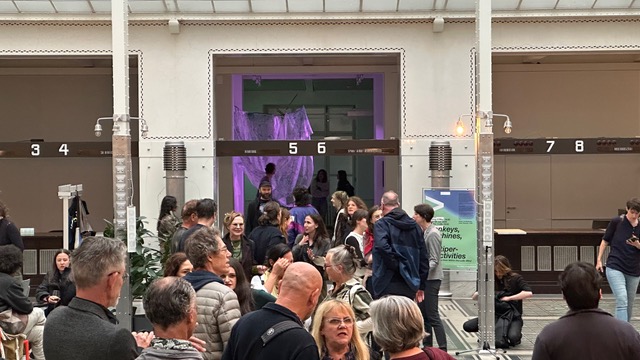

Situated within the physical manifestation of a game engine—a world-machine-conglomerate—this exhibition environment becomes a space where the playful mind engages with pressing universal issues, exploring them through experimental games. Multiperspectivity is the key concept driving this exhibition. It emerges as the first result of the experimental game series: a revolutionary game mechanic that enables rapid, unpredictable shifts in perspective. What happens when we change the lens through which we view the world? How can shifting our perspective alter the way we relate to our surroundings and to each other? Rather than seeking radical, sweeping change through traditional “revolutionary” means, we propose that change can occur situationally and continuously—by adjusting the way we see and understand things. This mechanism, applied here in a series of playful experiments, serves as both an artistic practice and a social principle. In our increasingly fragmented world, it offers a powerful tool for rethinking everything from democratic processes to environmental consciousness.
Through a self-reflexive exhibition game, the project offers an opportunity to actively participate in the unfolding experiments. Here, individuals are not passive observers but dynamic players within a fluid system of roles: whether as “involuntary” players, NPCs (non-playing characters), agents, researchers, or as curious lovers of ludic art. The exhibition blurs the lines between audience and performer, inviting participants to step into multiple roles, shifting from one perspective to another as they engage with the work. The exhibition also introduces non-human players into the role-play, expanding the concept of agency and offering a more inclusive view of interaction. These alternative modes of play, underpinned by computational neuroscience devices and techniques, transform scientific tools into artistic expressions focusing on empathy, creativity, and participation—can become vehicles for addressing ecological and social challenges.
For the critical analysis of LLMs in cooperation with the Austrian Research Institute for Artificial Intelligence a Citizen Science artwork ROBOPSY LLLM SWITCHER GAME is launched (tnX here to Fabian Navarro and the group)— to learn how OUR collective memory is affected by the use of the Large Language Models.
We critically address the often unwilling consent to surveillance and data harvesting in games: YOUR emotional face/ thought expressions will be the willingly given source to of constantly newly generated games, with new emerging game mechanics by LUDIC PSY AI game engine, developed under the lead of b in the PLRG artists. Parallel YOU, the player generate a physical RPG Role Playing board during the show. (YOU WILL FIND THE RESULTS of the daily game activity printed in 3D as a hexagonal Board game piece. YOUR daily art piece will be exhibited in a physical floating bounding box!
In a hybrid ludic assemblage, corresponding to avatars of OUR smoking players’ heads, represented in a TRIADE EEG head installation by Thomas Wagensommerer and Louise Linsenbolz, based on simultaneous brain scan data, you will find heads by sculptor Talos Kedl in symbiosis with electroencephalogram electrodes, that awake in the opening performance to life, as well as a activist NEST by the role-playing game enfleshing/bleeding Hollow group around
Xenobio activist Támas Pall, who critically investigated and researched lithium mining and its politically and ecologically devastating consequences.For You, the player, we now open our experimental game cultures lab: In this
artpiece/ show research processes and experiments are part of a playable environment. It builds on a conversation under a cherry blossom tree — with the research question: what is it like to play a tree?The concept video for Tree-game and a Tree voodoo performance by Margarete Jahrmann and Stefan Glasauer, as well as their concept Cre[AI]tor trained on artists’ drawings at the entrance gate – generate a NEW INDIVIDUAL CONCEPT of the Show for EACH PLAYER a.k.a. visitor!So it is as ambigous as play to tell You about what this show is.
When You enter this collective game art piece, You are welcomed, or my be physically lovingly caressed by a data ghost, made of delicate fabric, based on brain-scans of three exemplary players — because three players can already choose: to cooperate and to switch with whom they cooperate in each playround — that is a model for democracy – without hardened lines. And the TRANSMISSIONS from within the LUDIC MIND change….
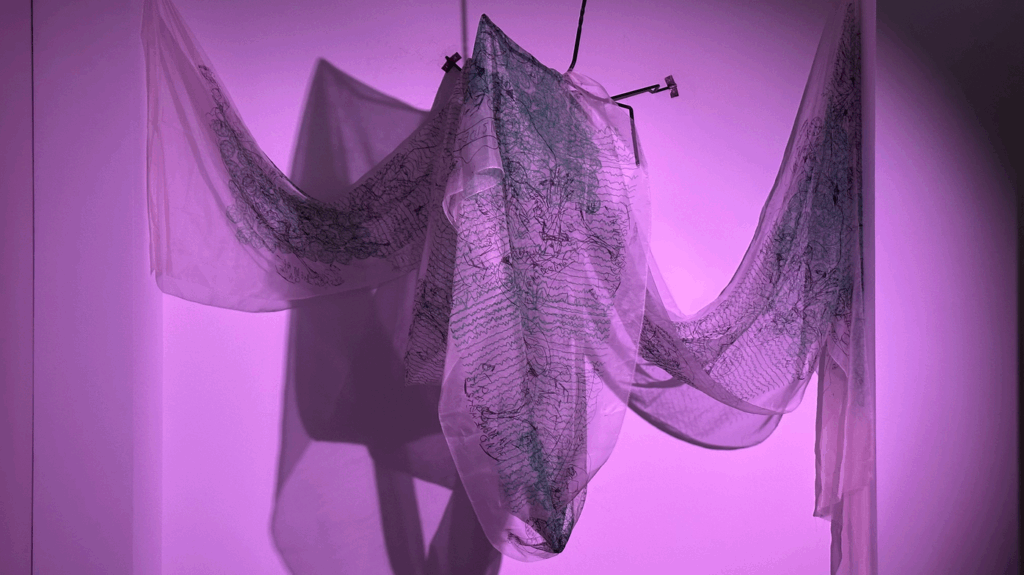
TREE GAME, a game constantly redrawn by visitors, is at the center of the exhibition, created with the help of the boardgames specialist Thomas Brandstetter, flanked by the swarm game by Stefan Maier and the drone paintings by Max Moswitzer created in a collective drawing game with drones (students participated in the prototypes- tnX to our students in EGC), which reverse war technology just as those drones opening the exhibition wrap their propellers in delicate green brain data fabrics.
SPECIAL and HEARTFUL THANKS to
Artists in alphabetical order: Thomas Brandstetter, Stefan Glasauer, Clara Hirschmanner, Margarete Jahrmann, Talos Kedl, Louise Linsenbolz, Georg Luif, Stefan Maier, Barbi Markovic, Max Moswitzer, Fabian Navarro, Thomas Wagensommerer.
The Psycholudic Approach. Exploring Play for a viable Future, Austrian Science Fund FWF/Program zur Entwicklung und Erschließung der Künste.
Project Lead: Margarete Jahrmann, Experimental Game Cultures, University of Applied Arts Vienna.
Partners:
Brigitte Felderer, Social Design, University of Applied Arts Vienna,
Matthew Pelowski, Department of Cognition, Emotion, and Methods in Psychology, University of Vienna,
ROBOPSY. An Artistic Exploration of Collective Memory through Role-Playing with AI Language Models, WWTF Vienna Science and Technology Fund
Project lead: Margarete Jahrmann with Barbi Markovic and Thomas Brandstetter, Experimental Game Cultures, University of Applied Arts Vienna.
Partners:
Stefan Glasauer, Computational Neuroscience, Brandenburg University of Technology Cottbus-Senftenberg, Germany,
Mark Coeckelbergh, Chair Philosophy of Media and Technology, University of Vienna
Robert Trappl, OFAI Vienna. Austrian Research Institute Artificial Intelligence
INTRA research project NEST, by Támas Páll together with Margarete Jahrmann and Thomas Wagensommerer, Experimental Game Cultures.
Transmissions from Within the Ludic Mind – PERFORMANCE
May 2025
In a situational lab setting the Psycho-Ludic Research Group (PLRG) combines physical and virtual artefacts, methods and practices, malfunctions and noise of our psycho-ludic research in a performative arrangement. PLRG wants to allow itself to reflect on its various strands of playful research and development and deep dives into an array of overlapping objects, actions, sounds and mechanics. PLRG encourages the audience to become participants to help us out doing so.
6. Mai 2025, 18:00 – Otto-Wagner PSK KASSENHALLE, Georg Coch-Platz 2, 1010 Wien
Against the backdrop of the research network The PSYCHOLUDIC APPROACH (FWF/Programm zur Erschließung der Künste), artists, experimental psychologists and neuroscientists meet to play with the innermost. It is about the outermost – the continued existence of the world and democracy in the interplay of non-human forms of being, nature and AI.
With political role-playing game consoles, we are launching the ROBOPSY (WWTF) project on role-playing with AI and the effects on collective memory. Multi-perspectivity proves to be a key concept. A game mechanic of spontaneous and unexpected changes of perspective can be applied to democratic processes and can thus be understood as a relevant principle of living together.
OPENING PROGRAM
Welcome: Maria Zettler (Managing Rector)Introduction exhibition
Performance by Psycho-Ludic Research Group (PLRG) – 250506_PLRG_LabMeeting

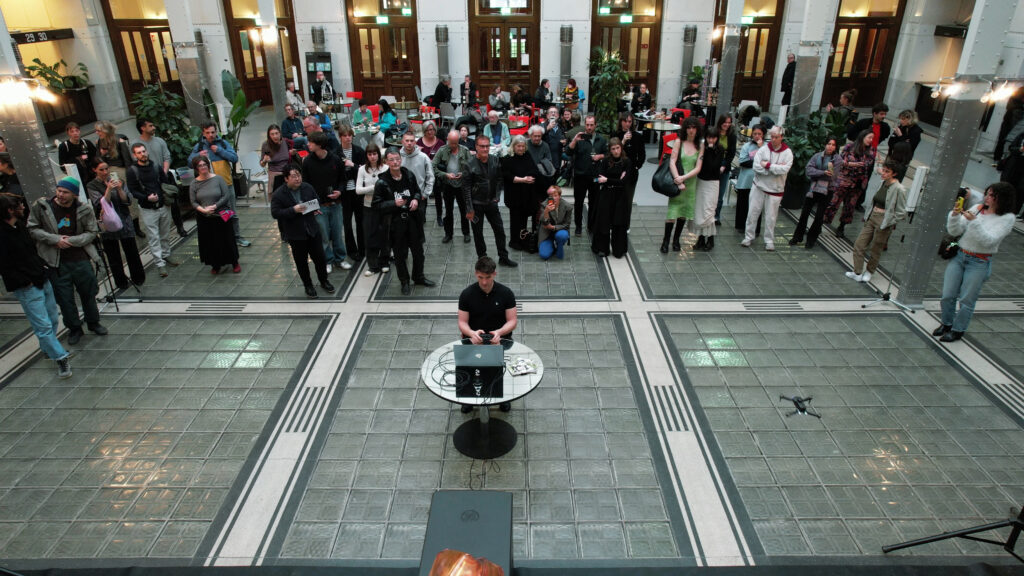
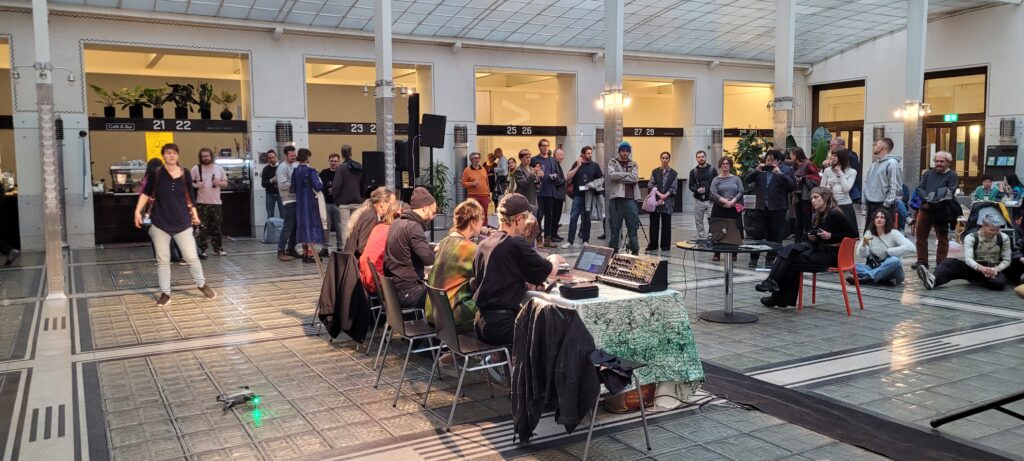
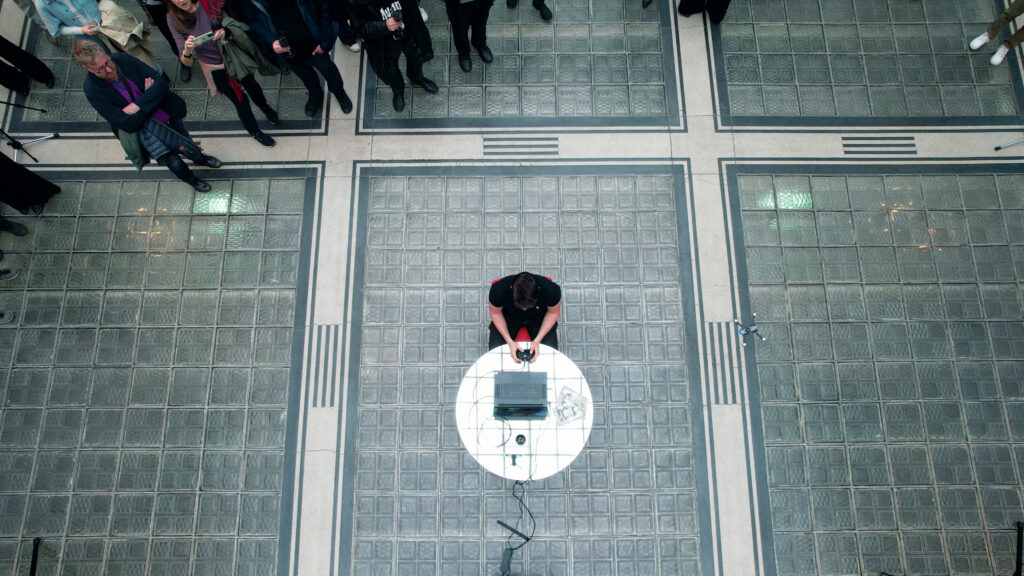

Multiperspectivity (Zoophytosymbiosis)
December 2024
On the occasion of #CATALIGHT #KT show: “AUS LICHT UND WASSER. VOM STREBEN NACH »OBERFLÄCHLICHKEIT«.
7th December 2024 till 26th January 2025 at Kunstverein Ulm.
Eine Topfpflanze vertritt in dieser Installation die Welt der Pflanzen. Es ist bekannt, dass Pflanzen auf Berührung reagieren – häufig mit Stress oder Abwehrreaktionen, weil sie Fressfeinde erwarten müssen. Andererseits bewegt auch der sanfte Wind, der für Bestäubung und Vermehrung sorgt, die Blätter. Diese Pflanze darf von Besucher*innen berührt werden, denn sie ist die Berührungsstelle zum Spiel. In der Folge illuminiert UV-Licht ein Muster auf dem Stoff – ein in der Neurowissenschaft routinemäßig verwendeter Farbstoff leuchtet auf.

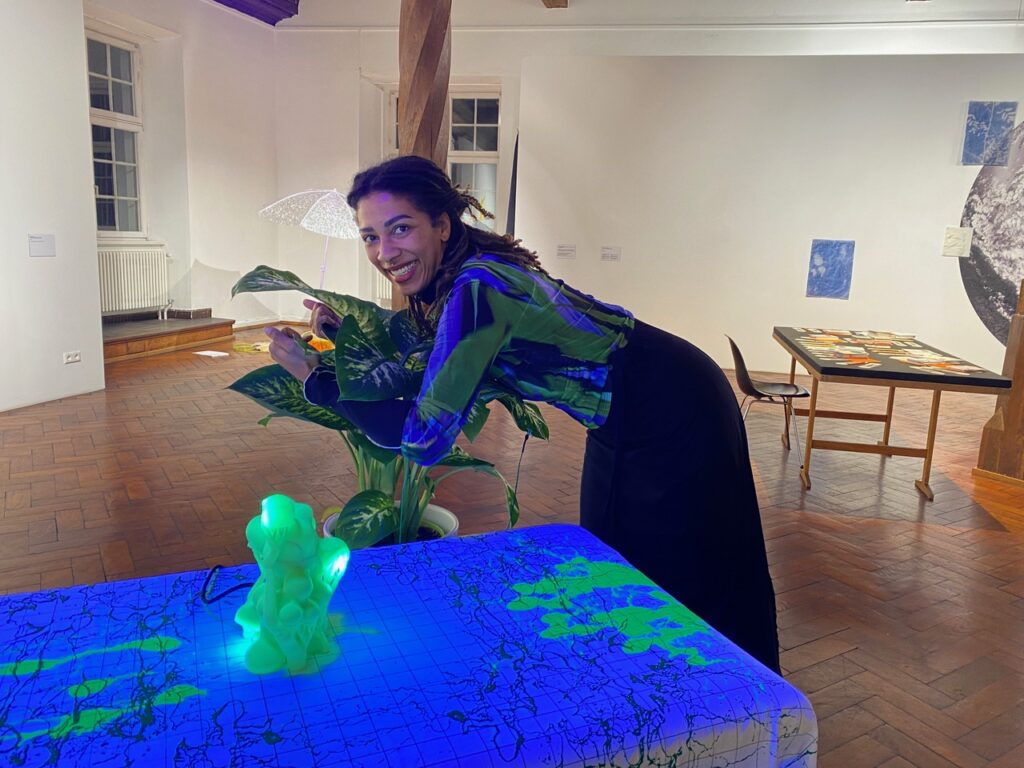
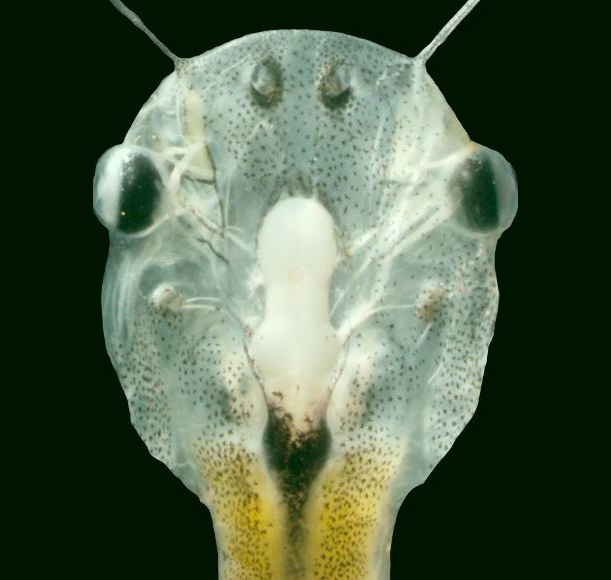


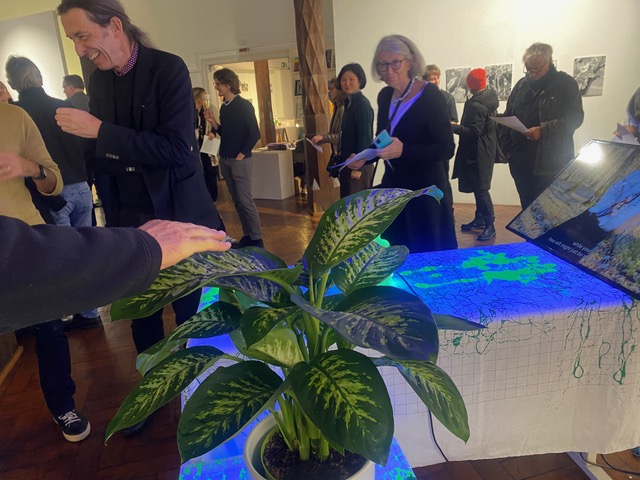
“Alexa Fluor 488” wird dafür verwendet, Nervenzellen anzufärben und bildet hier Kaulquappen-Nervenzellen ab. In einem wissenschaftlichen Experiment konnten einzellige Algen Gehirnareale von Kaulquappe des Krallenfrosches (Xenopus laevis) durch Photosynthese von innen mit Sauerstoff versorgen, wenn dem Kaulquappengehirn der Sauerstoff von außen entzogen wurde. Die Algen (Chlamydomonas renhardtii) waren durch Injizieren in das Gefäßsystem zu inneren Mitbewohnerinnen der Kaulquappen gemacht worden. Das Berühren der Pflanze und Auslösen des UV-Lichts in dieser Installation leuchtet die Möglichkeitsräume von “Photosymbiose” aus, die auch menschliches Gewebe mit Sauerstoff versorgen könnte. Die forschende Künstlerin Jahrmann gestaltet und druckt, durch sanftes Streicheln auf dem Stoff, die Nervenzellen als Stoffmuster.
Der Spieltrailer ist eingebettet in ein Setting, das an medizinische Untersuchungen erinnert. Zum einen verbindet Margarete Jahrmann damit ein Ausgeliefertsein. Zum anderen nutzen die Künstlerin und der Neurowissenschaftler Glasauer neurologische Untersuchungen für ihre Forschung zu alternativen Zielen und Belohnungskonzepten im Medium Spiel. Die meist unhinterfragten Mechanismen des Sammelns und Eroberns (collect and conquer) spiegeln unsere westliche Lebensweise auf dem Planeten und reproduzieren sie. Um andere Formen des Zusammenlebens erfahrbar zu machen, sind alternative Spielkonzepte wie “Multiperspectivity” wichtige Räume des Experimentierens und Lernens.
2024-12-09-11-06Margarete Jahrmann & Stefan Glasauer, Jahr: 2024/25
Materialien: Installation/ Filmessay zum TADPOLE – Addendum “TREEgame”, handgedruckter Stoff mit Alexa Fluor Green, Pflanzenobjekt, Elektroden, Controller Blau-Licht, Untersuchungsliege.
Concept Zeichnung, Stoffdruck und Design/ Konzept Pflanzen Connector Game: Margarete Jahrmann
Controller: Georg Luif
Blue Light Lamp „Tadpole“: Stefan Maier
Tadpole Scary Clip Elements: Louise Linsenbolz.
Film Essay: Stefan Glasauer.
www.kunstverein-ulm.de/ausstellungen/aus-licht-und-wasser-vom-streben-nach-oberflaechlichkeit
Autumn Workshop and Hyperscanning with EEG
September 2024
We recently hosted a two-day workshop where we explored the experimental game, 501 – Psycholudic Shuffle, in a unique setup that combined gameplay with neuroscientific measurement. The workshop brought together participants from diverse fields, including cognitive psychology, neuroaesthetics, and game design, to test the physical version of our game and conduct a cutting-edge EEG hyperscanning experiment.
About the Game
501 – Psycholudic Shuffle is a physical game designed for three players, where participants switch roles during gameplay, creating an ever-evolving and dynamic interaction. The game challenges traditional roles in play, aiming to explore cognitive and social dynamics in a creative environment.
The Experiment: Integrating Gameplay with EEG Hyperscanning
Following the initial gameplay, we transitioned into the core experiment using three EEGs to create a hyperscan of all participants. This setup allowed us to capture real-time brain activity from each player, overlaying in-game events with EEG data for deeper insights into the cognitive and emotional processes during play.
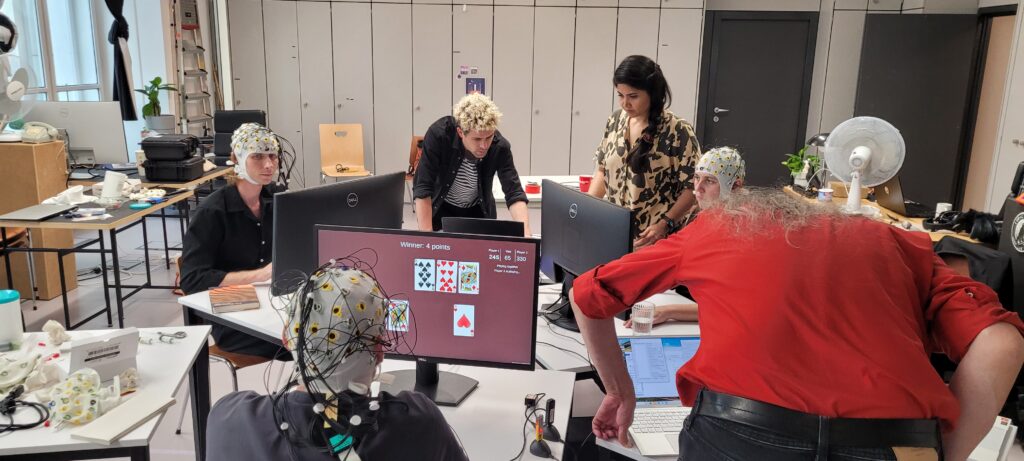
Key aspects of the experiment:
- Participants played the game for about half an hour with interfaces designed to minimize interference from traditional input methods like mouse or keyboard, enhancing the natural flow of the game.
- Data integration: In-game actions and events were synchronized with EEG data, creating a comprehensive view of how participants’ brains respond and interact during gameplay.
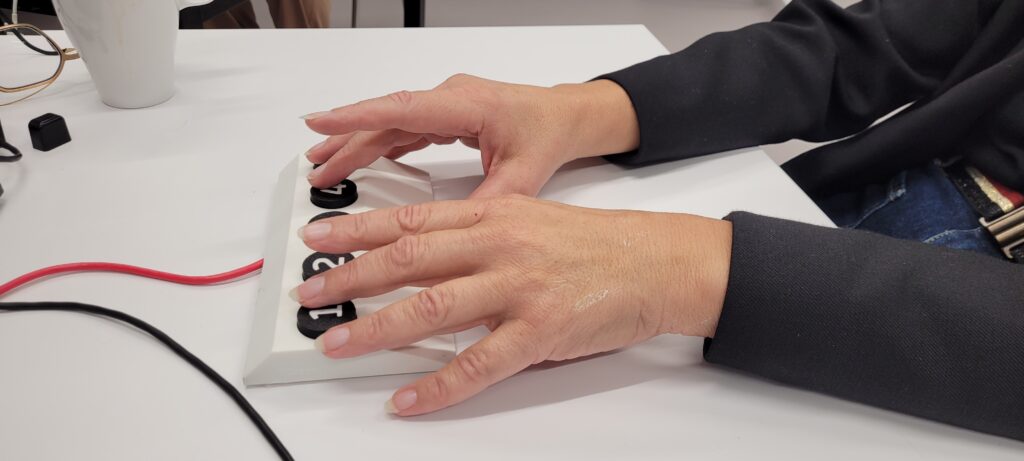
Participants and Collaborators
The workshop featured distinguished experts and artists from various fields who contributed to the discussion and analysis of the experiment:
- Margarete Jahrmann
Head of Experimental Game Cultures, University of Applied Arts Vienna - Matthew Pelowski
Assistant Professor, Psychology of Cognitive and Neuroaesthetics, University of Vienna, Faculty of Psychology - Stefan Glasauer
Computational Neuroscience, Brandenburg University of Technology, Cottbus - Zahra Shirzhiyan
Brandenburg Technical University - Theresa Demmer
University Vienna Artist Lab - Brigitte Felderer
Social Design, University of Applied Arts Vienna - Ryan Slaby
Università degli Studi di Milano Bicocca - Thomas Wagensommerer, Stefan Maier, Louise Linsenbolz, Max Moswitzer, Georg Luif
Members of research and artistic staff at the University of Applied Arts Vienna
Conclusions and Next Steps
This workshop marks a significant step in our ongoing research into the intersections of art, game design, and neuroscience. The data collected from this session will provide valuable insights into how we experience and interact during play, with future analyses planned to further explore the cognitive and emotional impacts of our experimental games.

Angewandte Festival 2024
July 2024
CRE[AI]D – A brain aided artistic image liberation game
June 2024
At A MAZE. Festival 2024 the installation titled Cre[AI]D was showcased, highlighting the intersection of traditional art and artificial intelligence. This installation continuously generates images using AI, trained on the drawings of artist Margarete Jahrmann.
Methodology
Cre[AI]D employs an AI system to produce its images. The first AI is dedicated to the visual output, ensuring that each image reflects the style and characteristics of the original drawings.
The process begins with the second AI, which generates prompts for the image creation. These prompts are derived from five randomly selected words taken from a book, introducing an element of randomness and speculative fiction into the generated art. Even the prompts that generate the images are now generated themselves.
Interactive Element
A significant feature of the Cre[AI]D installation is the large red buzzer present within the exhibit space. When pressed by a visitor, this buzzer initiates the image generation process. This interactive component allows visitors to engage directly with the installation, triggering the creation of new images with each press.

Continuous Image Generation
Cre[AI]D is designed to produce an infinite number of images, ensuring that the exhibit remains dynamic and ever-changing. The continuous generation of new art pieces means that each visitor experiences a unique set of visuals.
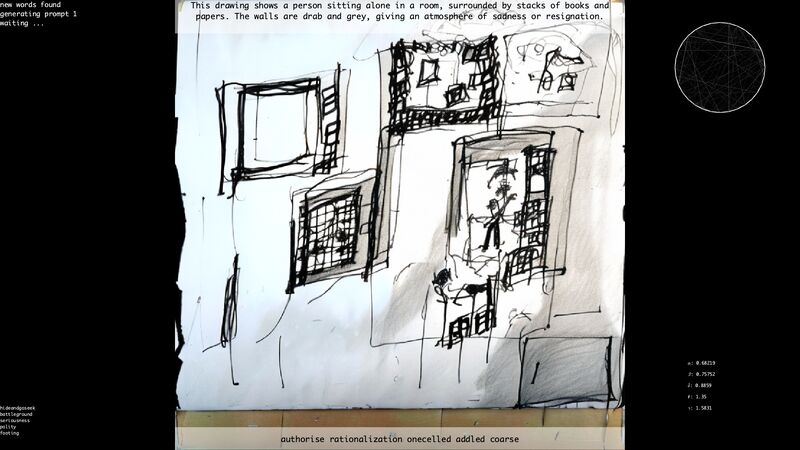
Playable 3D version
Explore our live online version directly in your browser, where you can generate images within a virtual representation of the “Postsparkasse”. Use the WSAD keys to navigate and your mouse to look around. Click on the one-armed bandit to generate a unique image.
